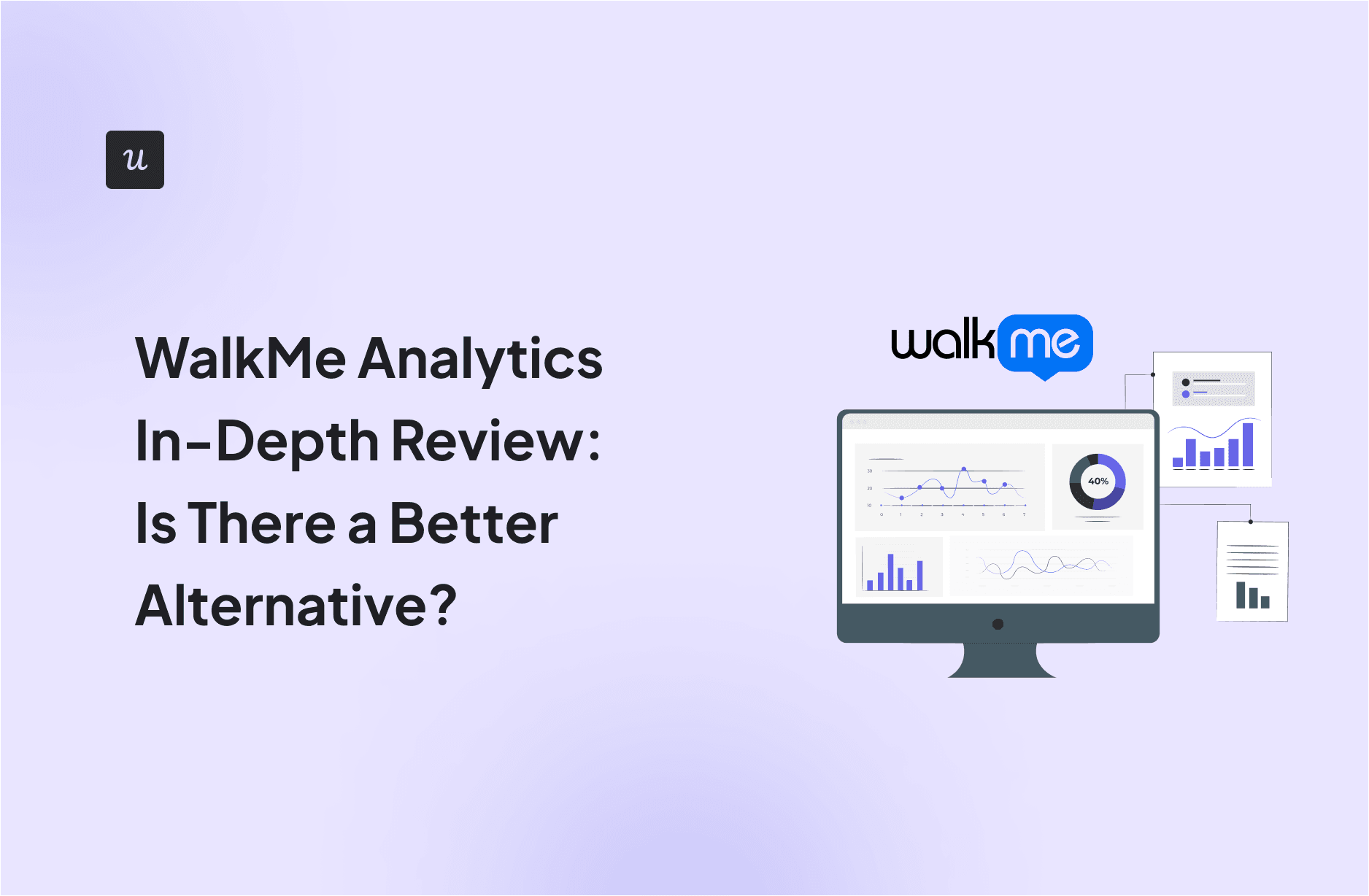
What analytics features does WalkMe support? What are its strengths and weaknesses?
These are the two main questions the article answers.
You will also discover three alternatives to WalkMe and learn about their analytics capabilities.
Let’s dive right in!
Try Userpilot Now
See Why 1,000+ Teams Choose Userpilot

TL;DR
- WalkMe is a digital adoption platform designed to facilitate customer and employee onboarding through in-app experiences, like interactive walkthroughs, on-screen guidance, and self-service support resources.
- The WalkMe Insights platform forms the core of WalkMe analytics. The specific analytics features available differ between the customer and employee onboarding solutions.
- WalkMe’s customer behavior analytics suite includes tools for user journey and guidance engagement analysis.
- Its features include funnel analysis, session recordings, AI-powered predictive analytics, and custom reports.
- The product usage analytics feature in WalkMe gives companies complete visibility of employee software usage patterns. This can help in gauging software adoption, detecting shadow IT, and optimizing the tech stack for better ROI.
- WalkMe’s workflow analytics help identify friction points that may be reducing efficiency.
- The form analytics feature in WalkMe is designed to diagnose inefficiencies in forms and questionnaires. WalkMe’s AI offers recommendations on how to optimize forms and increase completion rates.
- WalkMe’s pricing is available upon request, with reports suggesting it starts from $9,000 per year.
- WalkMe offers a drag-and-drop editor for non-technical users and supports both mobile and web applications. However, users may find the editor clunky and unintuitive. The platform has limited no-code customization options and a steep learning curve.
- Pendo provides more robust analytics tools but at a higher price point. Which makes it unaffordable for many small and medium-sized businesses.
- Appcues offers only essential analytics features at a more accessible price than WalkMe or Pendo.
- Userpilot provides more comprehensive analytics functionality than WalkMe and Appcues, and it’s more cost-effective and easier to implement than Pendo. Book the demo to find out more!
Is your WalkMe analytics setup justifying the investment?
WalkMe is a powerful tool, but it comes with high costs and complexity. Take this quick audit to see if you’re getting the most out of your WalkMe analytics.
What is WalkMe?
WalkMe is a digital adoption platform (DAP). It helps companies onboard their customers and employees through in-app experiences. Like interactive walkthroughs, on-screen guidance, and self-service support resources.
In addition to the engagement features, it allows you to run surveys and offers automation capabilities to make in-app workflows more efficient for your employees.
Finally, its product usage, workflow, and form analytics help teams make informed decisions and optimize the user experience.
Core features of WalkMe analytics
WalkMe Insights is WalkMe’s analytics platform, which allows you to track user engagement and behavior inside applications where WalkMe is installed.
The actual features vary between the customer and employee onboarding solutions.
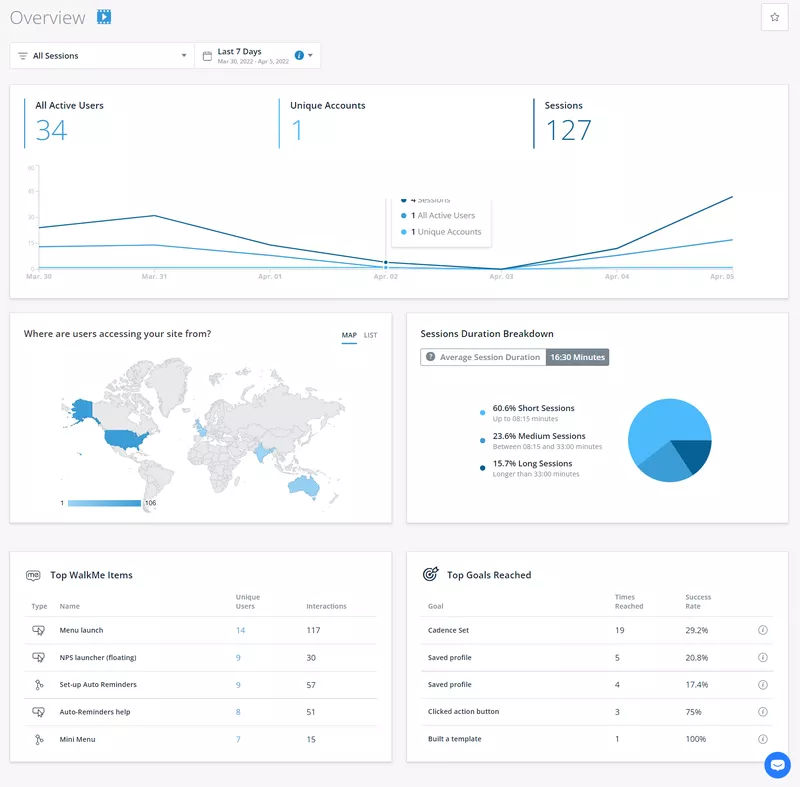
Customer behavior analytics
When it comes to customer data analytics, WalkMe offers:
- User journey analytics: You can conduct funnel and path analysis to see how users progress from one stage to another and identify friction points leading to drop-offs and increasing time to convert.
- Guidance analytics: It allows you to measure and analyze the performance of your in-app experiences and onboarding flows. This feature is also available in the employee solutions.
- Session stream and recordings: You can view and analyze the exact user action sequences, for example, to find the root cause of usability issues.
- Custom reports: You can customize the data displayed in the report for nuanced insights.
- AI predictive analytics: Uses historical user data to predict their behavior.

Product usage analytics
Product usage analytics enable you to automatically discover all software applications used by your employees, break the data down by role or department, and analyze how they use them.
That’s how you can gauge software adoption among employees and inform the onboarding process design. Or detect shadow IT and AI apps that may not be compliant with your company policies.
Combined with the license optimization feature, product usage analytics insights can help you optimize your tech stack, for example, by eliminating redundant software. To improve the ROI of your software.
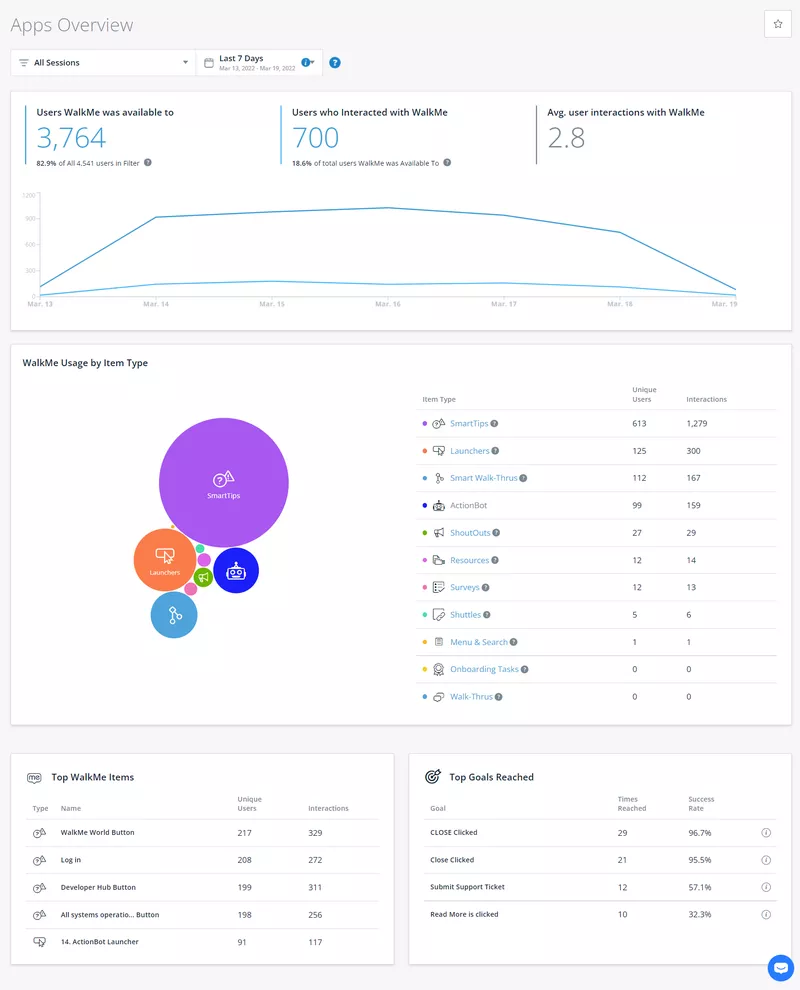
Workflow Analytics
Workflow analytics show you how employees interact with applications.
They can help you discover friction that’s reducing their efficiency.
How can you use such insights?
By providing additional on-screen guidance and embedding workflow automation to reduce empty clicks.
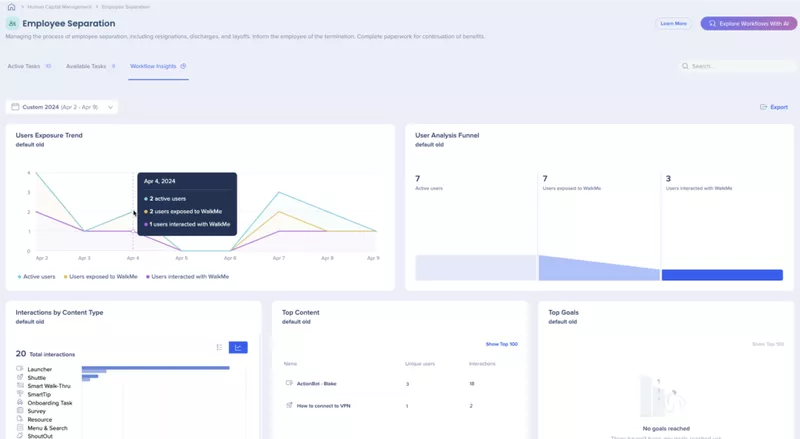
Form Analytics
Form analytics are useful for diagnosing inefficiencies in forms and questionnaires.
You can use them to understand where people make errors, get stuck, or drop off altogether.
Best part?
WalkMe’s AI offers recommendations on how to optimize the forms to reduce friction and increase completion rates.
WalkMe analytics pricing
WalkMe pricing is available upon request, but there are reports that it starts from $9,000/year, and customers have received around $20,000/year quotes.
What you can see from the pricing page, however, is that lots of the employee onboarding features are available as add-ons.
Is it good because it makes it more customizable? Or bad, because it adds unnecessary complexity?
I’ll let you decide for yourselves.
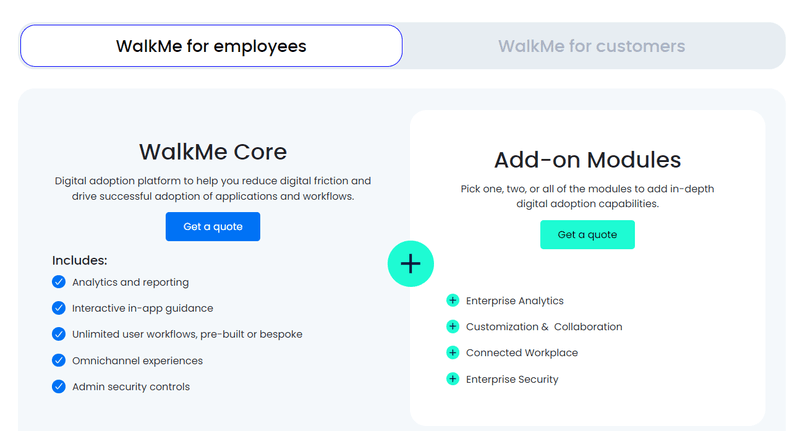
Pros and cons of using WalkMe
What are WalkMe strengths and weaknesses? Let’s unpack the key ones.
WalkMe Pros
- Drag-and-drop editor: It enables non-technical users to create flows without coding.
- Employee onboarding: Companies can use it to train new employees, introduce new software, or support digital transformation initiatives.
- Cross-platform support: It supports mobile and web apps, enabling organizations to design omnichannel onboarding experiences.
WalkMe Cons
- Drag-and-drop editor: While the first impression of the tool is positive, users find it clunky and not very intuitive to use.
- Limited customization: You need CSS skills to give your tooltips and pop-ups a native appearance.
- Steep learning curve: The tool is complex and, as a result, challenging to learn.
Is there a better alternative for WalkMe analytics?
Are you concerned by WalkMe’s complexity? Do you need more in-depth analytics? Does the pricing look too steep?
If the answer to any of the questions is ‘Yes,’ you might want to consider an alternative digital adoption platform.
Here are 3 top choices: Userpilot, Pendo, and Appcues.
Userpilot
Userpilot is a product growth platform.
It allows PMs, PPMs, designers, and CSMs to collect qualitative and quantitative customer data via surveys and event tracking, analyze it, and use the insights to design in-app experiences.
For example, to onboard new customers, improve new feature discovery, and offer contextually relevant guidance and self-service support.
Core features of Userpilot analytics
Userpilot comes with powerful analytics that match the capabilities of dedicated analytics tools.
They include:
- Real-time analytics (so you can respond to events as they happen).
- Autocapture (for automatic event tracking).
- User segmentation (for granular analysis).
- Funnels and Paths (for user journey tracking).
- Trends and Retention analysis.
- Custom analytics dashboards (for easy access to related reports in one place).
- A/B and multivariate testing.
- Flow analytics (to measure engagement with in-app experiences).
- Integrations with 3rd party analytics and CRM tools, like GA4 or Salesforce (for complete customer journey analysis).
And there’s more to come: you can expect session recordings soon, which will make Userpilot an even more comprehensive user behavior analytics solution.
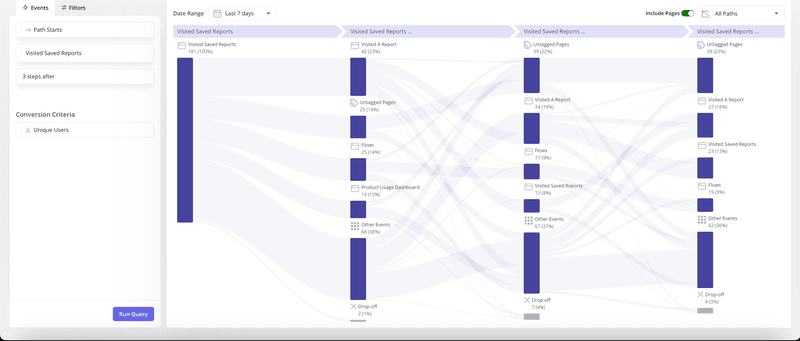
Userpilot Pricing
You have a choice of 3 pricing plans:
- Starter: The entry-level Starter plan is priced at $299/month, billed annually. It includes up to 2,000 Monthly Active Users (MAUs) and features like segmentation, product analytics, reporting, in-app user engagement, NPS surveys, and UI customization. This plan is only available on an annual subscription basis.
- Growth: Custom-priced, the Growth plan adds support for custom MAUs, advanced product analytics, retroactive event auto-capture, in-app surveys, session replay (add-on), resource centers, AI-powered content localization, EU hosting options, and a dedicated Customer Success Manager.
- Enterprise: Custom-priced and designed for large organizations, the Enterprise plan includes everything in Starter and Growth, plus premium integrations, bulk data export/import, data warehouse sync, custom roles and permissions, SAML SSO, activity logs, priority support, custom contracts, SLAs, and security compliance (SOC 2 Type 2/GDPR).
You also get a free 14-day no-credit card trial.

Pros and cons of Userpilot analytics
Userpilot offers a whole host of features that most other DAPs don’t. For example, autocapture or session replays.
Moreover, the tool is intuitive to use and doesn’t require extensive training. Or coding.
This makes it more accessible: you don’t need to be a data analyst or developer to track events, generate reports, and analyze the data.
Finally, it offers MAU-based pricing. This makes it easier to estimate your costs than event-based pricing used by some of the analytics tools.
How about downsides?
Lack of support for mobile apps is one. You can’t design onboarding experiences for mobile app users or analyze user behavior inside such products.
Moreover, it isn’t suitable for employee onboarding.
Pendo
Pendo is a well-established adoption software catering to medium-sized and enterprise-level companies.
Just like Userpilot, it offers user engagement, feedback, and analytics features, and overall, it’s one of the stronger players in the DAP market.
Core features of Pendo analytics
Pendo used to be known for its excellent analytics. Competitors have caught up now, but it doesn’t change the fact that it’s still a potent analytics solution.
Its features include:
- Retroactive analytics (autocapture).
- User segmentation (using various properties, e.g., location, survey responses, or operating system)
- Behavioral analytics (Funnel, Paths/Journeys, and Cohort Analysis).
- Cross-app journey tracking (For customers using different devices/platforms).
- Data Explorer (for custom reports).
- Session replays with frustration indicators.
- Custom dashboards.
- A/B testing.
- Integrations with 3rd party tools, making it easy to collect, store, and analyze data from different sources in one place.
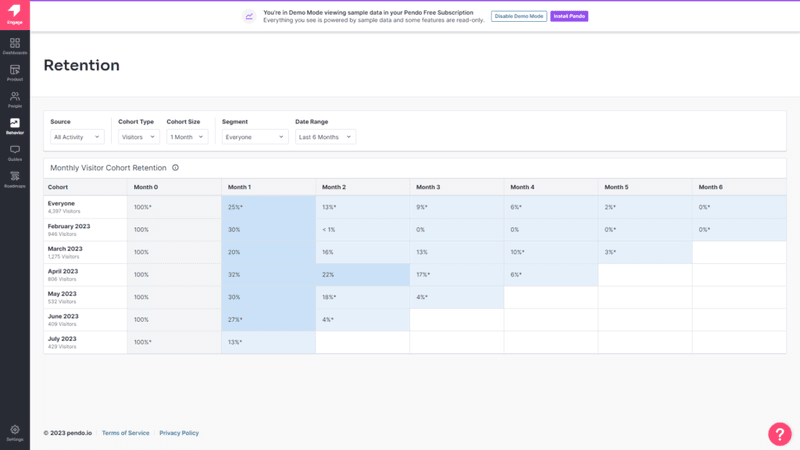
Pricing
During my three years as a writer specializing in product management and adoption tools, I haven’t seen a company that would change its pricing plans as often as Pendo.
Currently, there are five pricing plans on the Pendo website:
- Free.
- Base.
- Core.
- Pulse.
- Ultimate.
All of them, apart from the free one obviously, come with custom pricing, which is reportedly on the steep side. Online reviews mention figures in the $50K/year ballpark, but all this depends on the number of MAUs.
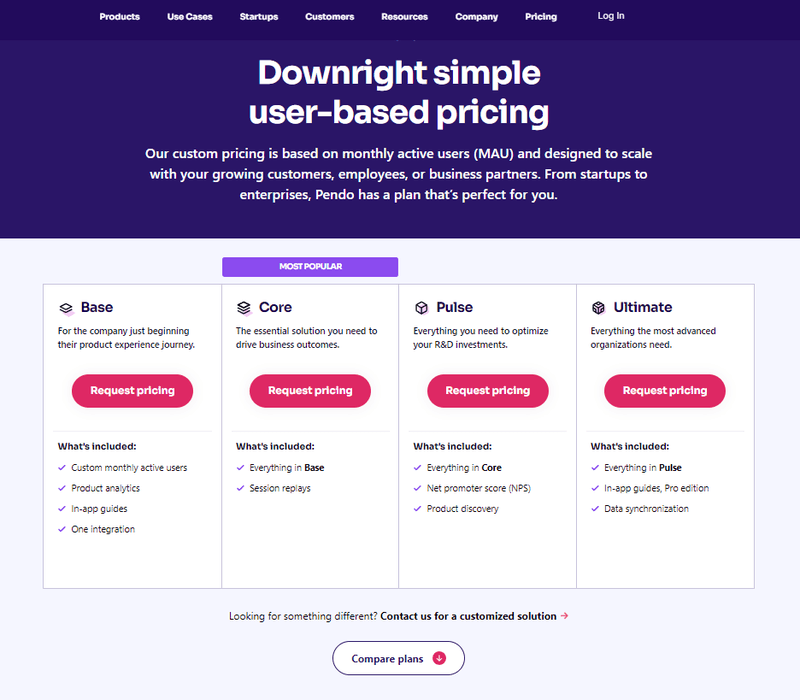
Pros and cons of Pendo analytics
Let’s be clear: Pendo is a superb analytics tool. Its strengths include:
- Comprehensive functionality: Its capabilities are more than adequate for most product teams.
- Ease-of-use: Once set up, Pendo is easy to use, even for non-technical users, which makes adoption straightforward.
- Out-of-the-box capabilities: Pendo’s analytics require minimum setup so teams can start collecting data and analyzing insights quickly.
- Mobile support: Like WalkMe, it can be used for mobile app
What lets Pendo down?
- Pricing: The tool isn’t affordable for most small and medium-sized businesses. Userpilot gives you similar capabilities with a much lower price tag.
- Lack of real-time data reporting: There’s a lag in data reporting. Only admins can see it in real time; this means you can’t respond to events as they happen.
- Customization: Pendo is highly customizable, which makes it hard to set up for organizations without experience or technical expertise.
Appcues
Appcues is also a digital adoption platform.
At a glance, it offers the same capabilities as the other tools: You can collect user feedback, engage and support them with in-app flows, and track engagement with analytics.
Core features of Appcues analytics
While Appcues’ engagement or feedback features are pretty decent, the same can’t be said about its analytics. These are basic.
All you get is:
- Event tracking (to track product usage).
- Experience reporting (to measure the performance of onboarding flows).
- A/B testing and experimentation.
- User segmentation (for targeted engagement).
- Integrations with analytics tools like Amplitude, Logrocket, Fullstory, and GA.
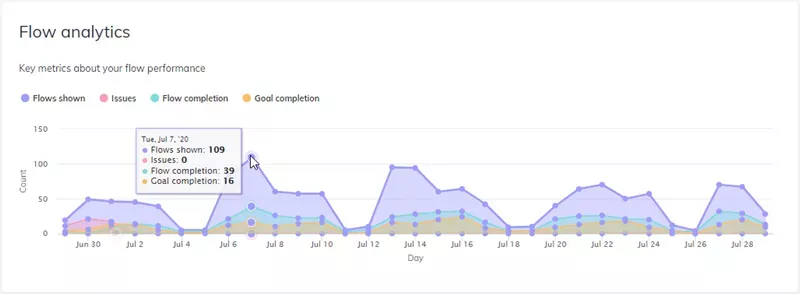
Pricing
Appcues has 3-tier pricing. The available plans are
- Essentials – from $300/month.
- Growth – from $879/month.
- Enterprise – custom pricing.
So, it is slightly pricier than Userpilot for the higher plans but more affordable than WalkMe or Pendo.
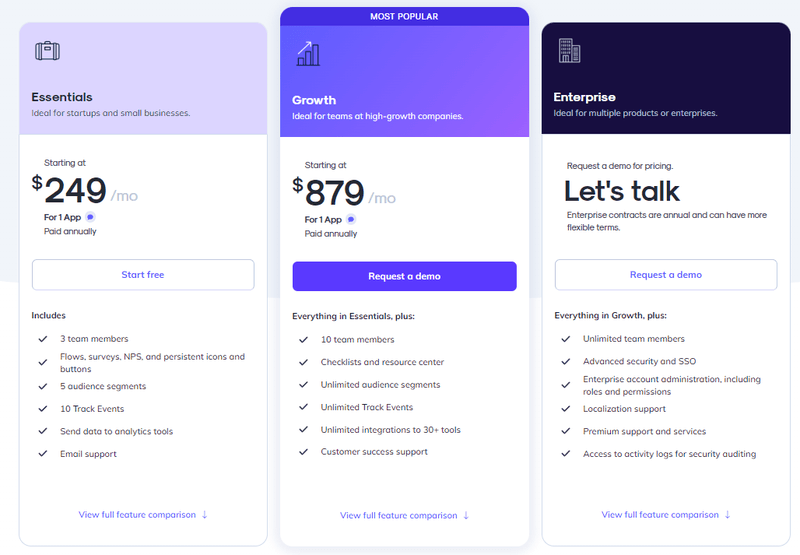
Pros and cons of Appcues analytics
The main strength of Appcues analytics is that it’s pretty straightforward and intuitive to use.
Moreover, Appcues supports event-based triggering, so you can automatically send surveys and in-app flows in response to user actions.
Finally, you can use Appcues for mobile app onboarding and user engagement tracking.
As to the downsides, its functionality is limited. You don’t get funnel, path, or retention reports, which restricts your ability to make informed decisions without using another analytics tool.
And just like in Pendo, the event data isn’t reported in real time.
Last but not least, the usage caps in the lowest plan (3 team members, five audience segments, and 10 track events) considerably limit its usefulness.
Conclusion
WalkMe delivers a range of analytics features that the other platforms don’t, like cross-organizational application usage and workflow monitoring or license optimization. This makes it a more comprehensive employee onboarding, digital transformation, and change management tool.
However, in customer onboarding, WalkMe analytics functionality places it somewhere in the middle of the field. It’s more capable than Appcues but not as good as Userpilot or Pendo.
If you’d like to learn more about Userpilot analytics, and how to leverage them to enhance new users onboarding, book the demo!







